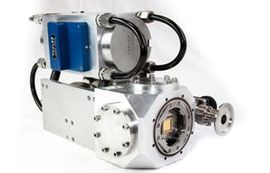Meyreuil (FR), November 18th, 2015 – On October 28th 2015, at the Adaptive Optics for Extremely Large Telescopes international conference held in Lake Arrowhead, USA, First Light Imaging showed for the first time images captured by C-RED, the new infrared camera created by the company.
A world record of 3507 images per second full frame with sub-electron readout noise has been achieved, while competitors are more than four times slower.
Using a revolutionary e-APD (Avalanche Photodiodes) sensor which allows noise free signal multiplication, C-RED is now the fastest scientific infrared low noise camera in the world.
With its state-of-the-art high-reliability pulse-tube cooler, C-RED is completely autonomous and does not need complex cryogenics instrumentation. Its fully integrated system can operate in extreme environmental conditions and only requires simple electric power supply and water cooling.
With its infrared wavelength coverage from 0.8 to 2.5 microns and unprecedented performances, C-RED can make the invisible visible.
C-RED is currently opening a new era in for Astronomical, Biomedical, Industry and Defense imagery.
Its commercialization is scheduled by 2016.
Start-up created in 2011, emanating from public research laboratories[1], First Light Imaging designs and manufactures high-technology scientific cameras. The company has already been funded twice by the Ministry of Higher Education and Research and the Public Investment Bank (BPI) in France.
First Light Imaging is also laureate of the Horizon 2020 SME Instrument program from the European Commission.
Its flagship product, OCAM², is the world's fastest and most sensitive camera for visible wavelengths.
OCAM² is already chosen by the world's biggest telescopes such as the Subaru Telescope in Hawaii or GranTeCan in Spain.
First Light Imaging also brings its expertise to the NASA spatial agency.
